Where to plant spring bulbs + spring garden tour
I asked the head gardener of Doddington Place Gardens, Lucy Adams, for her top tips on where to plant spring bulbs, how to choose them and other key spring bulb information.
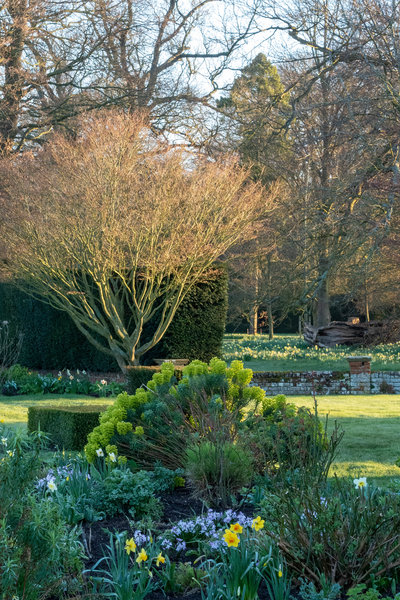
There are daffodils in the woodland as well as in the formal Sunk Garden at Doddington Place Gardens.
Plan bulbs to flower from February to June
Lucy’s main aim is to have bulbs in flower from February to June, so they’re a major part of a year round garden. The alliums dominate in May and June. But tulips, daffodils, muscari and hyacinths can flower from February to May between them.
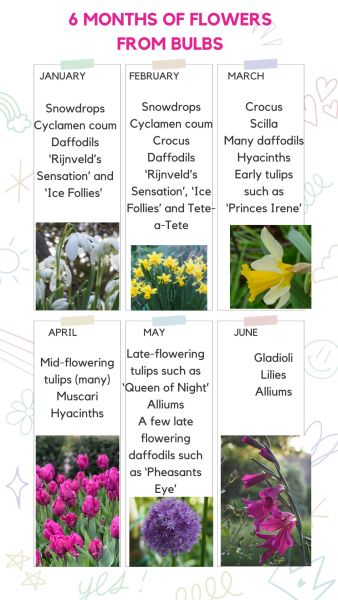
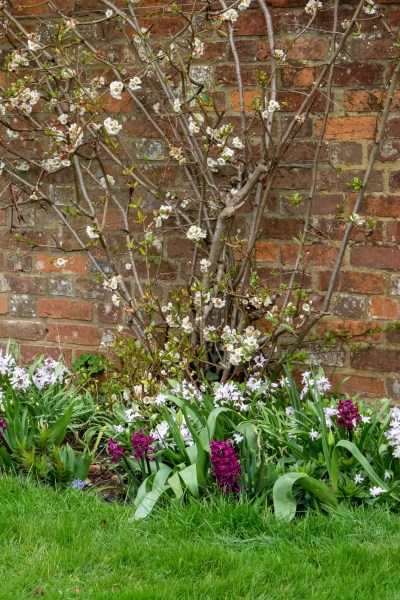
Two contrasting hyacinth colours echo the pink-tinged blossom above.
Decide on a colour theme
When planting bulbs in borders, Lucy likes to decide on a colour theme. She then researches the bulbs available in that colour, looking for those that flower at different times.
Once she’s made her choice for a particular border, she creates a mix of varieties and puts the mix in a bucket. She plants from there, so there is some planning but it’s not too rigid.
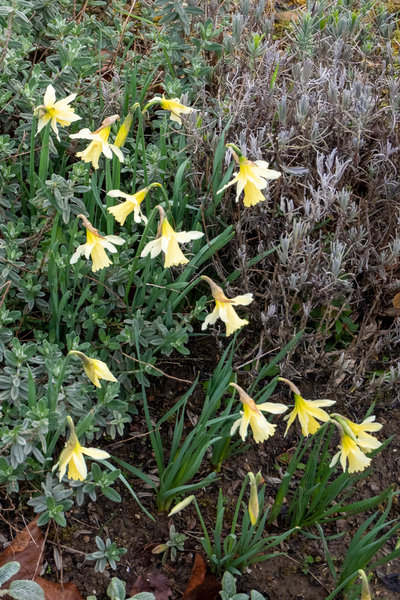
This combination of pale yellow daffodil and grey foliage is very pretty.
When deciding on colours, Lucy sometimes chooses a single colour. For example, the Ghost Border solely has white bulbs.
Or she will contrast flower colours, such as yellow daffodils and blue muscari. Another choice is to harmonise colours, matching a pale lemon daffodil to the pale yellow flowers of a nearby shrub.
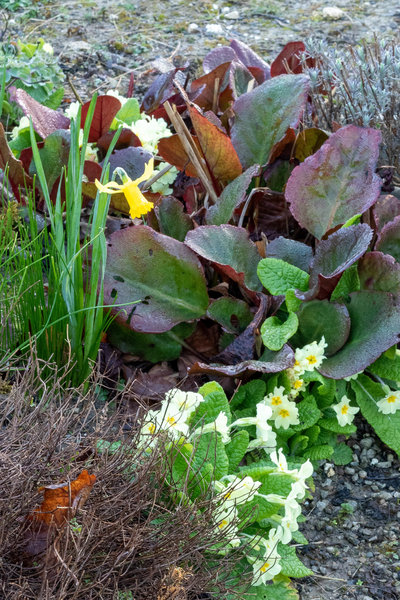
This grouping has the yellow of the daffodil harmonising with the primrose. Both contrast nicely with the red leaves of the Bergenia (Elephant’s Ear). There is more about daffodils in this post here.
She also thinks about the foliage. In the Rock Garden, there is a swathe of yellow daffodils near a clump of zingy green euphorbia. It’s a fabulous combination, but the addition of purple leaved hebe to the grouping makes it even better.
‘Primroses and primulas also go well with bulbs and they self-seed themselves. And you can get some wonderful colours now, not just the ones you see in the supermarket.
Where to plant spring bulbs
There are many places for planting bulbs at Doddington Place – in naturalised swathes in lawns and under trees, fringing the paths round the garden, in borders as part of a scheme and in pots.
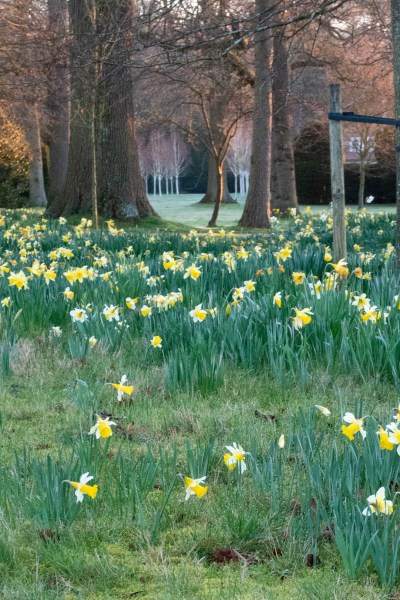
Naturalised daffodils in the lawn at Doddington Place Gardens
For those of us in smaller gardens, this equates to under trees, in lawns, edging paths, in borders and in pots.
So I asked Lucy for the tips that would work in our rather smaller middle-sized gardens.
Spring bulbs in formal borders
At the heart of Doddington Place Gardens is the Sunk Garden, where a formal bedding scheme surrounds a pond. It’s edged by ancient and structural yew hedging and the house’s imposing chimneys peer over them.
The advantages of having spring bulbs in borders is that emerging perennials and other planting covers up the dying leaves of the bulbs.
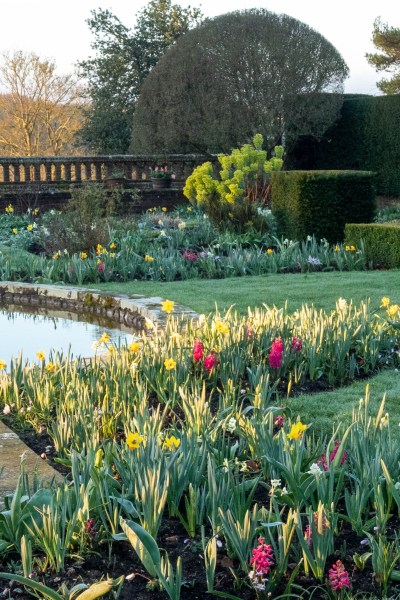
This is a stunning herbaceous border in summer and autumn, so Lucy digs up the bulbs to make way for the cosmos and other plants.
But if you garden intensively in your formal borders, Lucy advises digging your bulbs up at the end of the season. The borders at Doddington Place have to be stunning. In the summer they’re packed with cosmos. So leaving bulbs in after they have flowered would cut down on planting space.
So the decision on whether to dig up your daffodils and hyacinths when their flowers are over will depend on how showy you like your borders to be.
You can see Doddington Place Gardens’ borders in some other Middlesized Garden posts, including Which Hedge is Right For Your Garden.
Colour theme a spring border
There is the ‘Ghost Border’ running alongside the Sunk Garden, where the theme is grey and silver. Lucy plants only white spring bulbs here, choosing a range of white daffodils that will flower from February to May. Once again, she’ll plant the bulbs in informal groupings with different kinds of daffodils together.
But if you are going for a really controlled colour scheme like this, then she says you need to add an accent colour to show off the more muted colours. She’s added some green to show off the silver and grey, with green and white spotted pulmonarias.
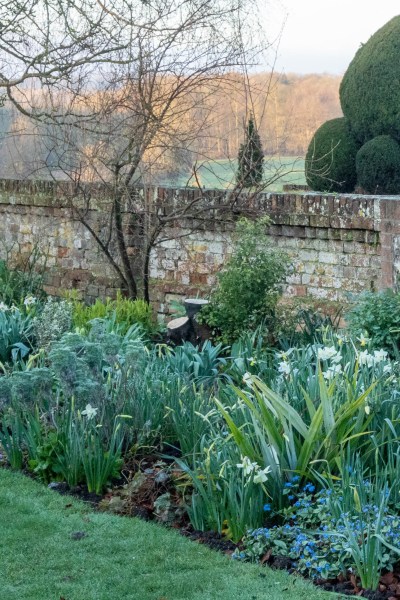
The ‘Ghost Border’ is themed with grey and silver, with white bulbs. But there are pops of brighter green leaves to add some zing and prevent it from looking too muted.
There is a border by the tea room where Lucy has chosen a theme of pink daffodils, – they’re more of a peach colour really but they really glow here.
What are the best spring bulbs for naturalising?
Lucy says that most daffodils will naturalise, so you can choose your favourites. However, it is important to make sure that you plant them in a natural way. ‘The human eye is very good at creating patterns.’
Once again, she puts her collection of daffodil bulbs in a bucket and then tosses handfuls of bulbs across the lawn, planting them where they drop.
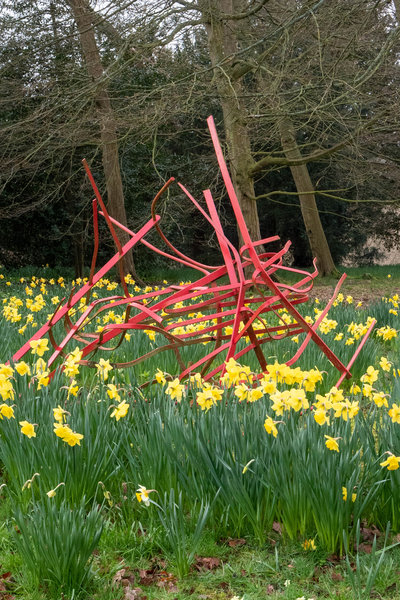
Yellow daffodils naturalised in the woodland at Doddington. I particularly like the contrast of the red ‘sculpture’ with the yellow daffodils. The sculpture is actually a run of park railings. Someone crashed their car into it.
The best bulbs to plant under trees
You can plant any bulbs directly under deciduous trees because their leaves will be off when the bulbs are in flower. There’ll be plenty of light. Later on in the year, the canopy of leaves will mean you can’t grow much directly under the trees.
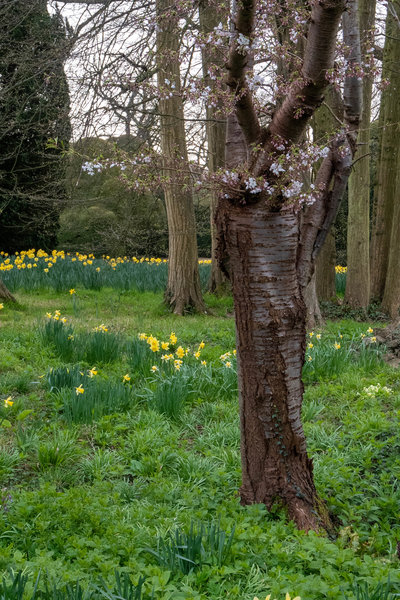
A carpet of bulbs in the woodland at Doddington Place Gardens. Although bulbs do need light, they are fine under deciduous trees because the leaves are off during the winter and early spring.
Bulbs for shady places
Bulbs do need some light so if you have a shady border plant them on the edges where they should get some light.
Doddington Place Gardens has a wilder ‘woodland’ garden where there are tall trees and lots of azaleas and rhododendrons. They plant spring bulbs on the edges of paths there.
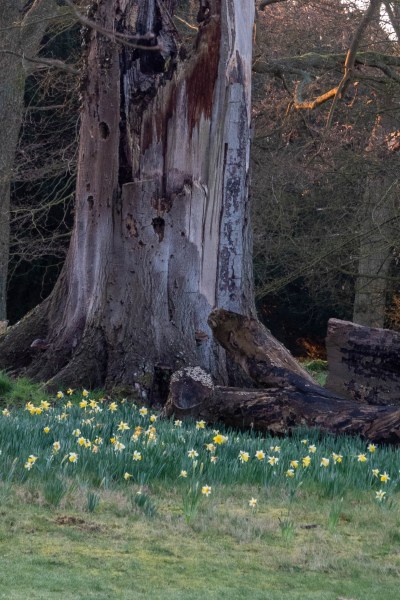
Daffodils under woodland at Doddington Place Gardens
See this video for woodland planting advice from Doddington Place Gardens.
‘If an area is very shady, I plant hellebores instead of bulbs,’ says Lucy, ‘because they tolerate shade very well. Violets also work well in shade, as do primulas and primroses.’
What to do with spring bulbs after flowering
Lucy digs up the bulbs in the formal borders at Doddington Place. She then cleans off the soil, lets them dry and stores them somewhere cool and dark. They can be re-planted the following autumn.
She leaves the daffodils in the lawns and woodland in, so they can spread and naturalise. It is important, however, to allow the leaves to die back naturally for at least six weeks. And don’t tie them up – that will stop nutrients getting back into the bulb.
There’s more advice on what to do with bulbs after they’ve flowered in the post ‘Answers to the top 5 spring gardening questions.’ It answers questions such as ‘why are my tulips so short?’
Will spring bulbs grow through gravel, mulch or bark chippings?
Yes, they will, says Lucy.
Plant spring bulbs on slopes
One striking feature of Doddington Place Gardens is its Edwardian rock garden which was restored several years ago. It slopes down from the Sunk Garden to a pond and then onto the woodland, and is an ideal place for bulbs.
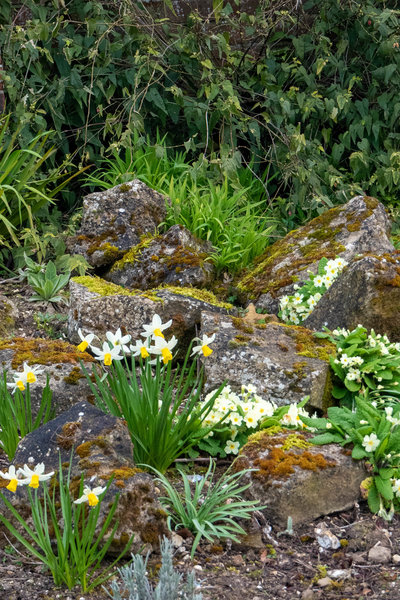
Daffodils planted in little pockets on the slopes in the Rock Garden.
‘Slopes are good places to plant bulbs,’ says Lucy, because you can see them. She plants them either in little pockets or a small swathe stretching across the slope.
How to plant spring bulbs in pots
Lucy says that all bulbs are fine to grow in pots. You don’t have to buy specific ‘for containers’ variety.
But she does warn that you should check heights. ‘If you have a very short plant, it may not be seen above the rim of the pot,’ she says. ‘And a very tall daffodil or tulip will bend in the wind more easily in a pot.’ That’s presuming your pots are somewhat exposed – it would probably be different if they were tucked into the corner of a terrace.
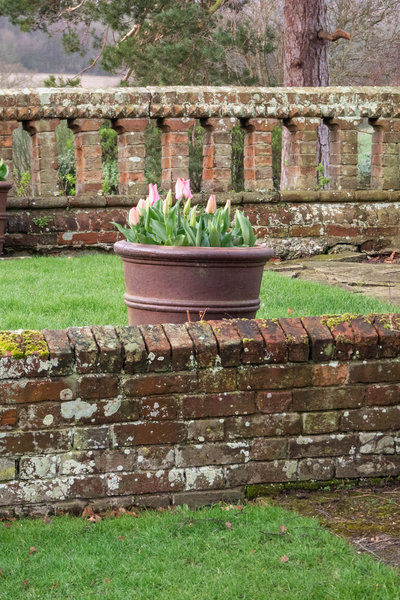
Tulips work well in pots. There was an attack of tulip virus at Doddington Place Gardens a few years ago and it stays in the soil for years, so they now grow very few tulips. However, you can grow tulips in pots if your soil is infected by using fresh potting compost.
Spring is the time to evaluate your garden for next year
Lucy follows Fergus Garrett’s advice to keep a notebook with you when you’re in the garden.
It’s particularly important to take notes or photographs of the garden at this time of year. Keep a record of what works and what doesn’t, and where there are gaps.
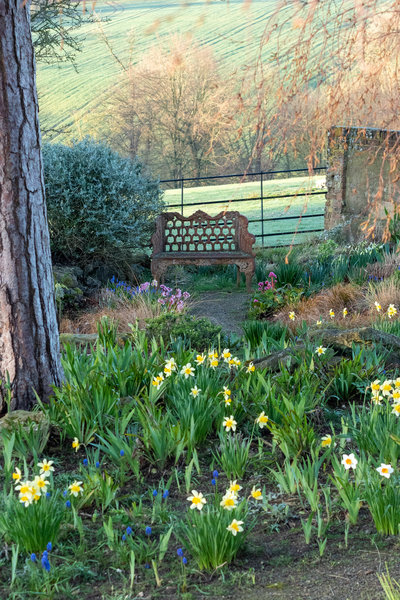
You will never remember where the daffodils, hyacinths and muscari are when it comes to planning your spring bulb purchases in autumn. Take notes! Seen in the Rock Garden at Doddington Place Gardens.
Because when the time comes to plant spring bulbs later on, this year’s bulbs will all be underground. You’re likely to have forgotten where the gaps were and what effects you most wanted to achieve.
If it’s been a hard winter, you may have plants or trees that look damaged. Don’t panic! Here is Lucy Adams’ advice on how to deal with winter damage on your plants.
If you can visit a garden..
And you can also take notes or photographs when you go round other gardens. Although large gardens work on a more spectacular scale than we can in our middle-sized gardens, there are always ideas we can take away from a beautiful garden like Doddington Place Gardens. It’s usually open between Easter and September on Sundays and Wednesdays.
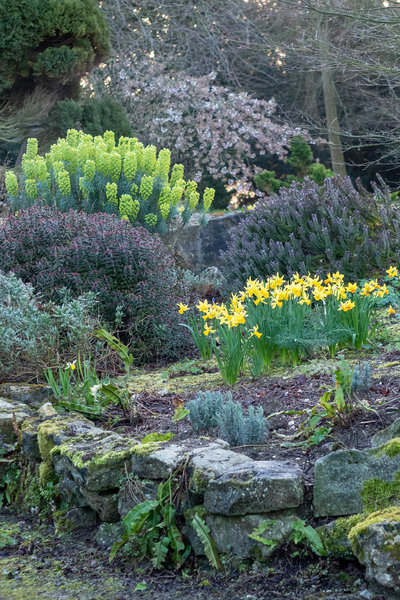
I love this combination of bright green euphorbia, purple hebe and a swathe of yellow daffodils in the Rock Garden at Doddington Place Gardens.
You can also record or photograph good bulb combinations in front gardens in your local street, too.
Or visit gardens that specialise in spectacular bulb displays, such as Hever Castle’s tulip festival. See head gardener Neil Miller’s advice on growing tulips here.
More spring gardening tips
Find out more about how to grow daffodils here. And see here for the ultimate guide to how to plant and grow tulips.
Find answers to the top 5 spring gardening questions here. And if your spring garden is in pots, then check out Dan Cooper’s advice on how to group pots into a border display here.
Shop my favourite garden books, tools and products
I’m often asked for recommendations so I’ve put together some useful lists of the tools, books and products I use myself on the Middlesized Garden Amazon store. For example, this is a list of gardening essentials, such as good gardening gloves, kneelers and a good windowsill propagator to get your seeds started when spring is cold.
Note that links to Amazon are affiliate, which means I may get a small fee if you buy, but that doesn’t affect the price you pay. And all the products on the Middlesized Garden Amazon store are ones I use myself.
Pin to remember spring bulb planting ideas
If you are restricted on where you can go at the moment, I hope you’ve enjoyed seeing pictures of this beautiful garden. For more interviews with experts and ideas from other (often middle-sized) gardens, do join us every Sunday morning – follow by email here.
*Coronavirus note: Doddington Place Gardens’ owners kindly let me photograph and film at 6am when no-one else was around. I interviewed Lucy Adams by phone.
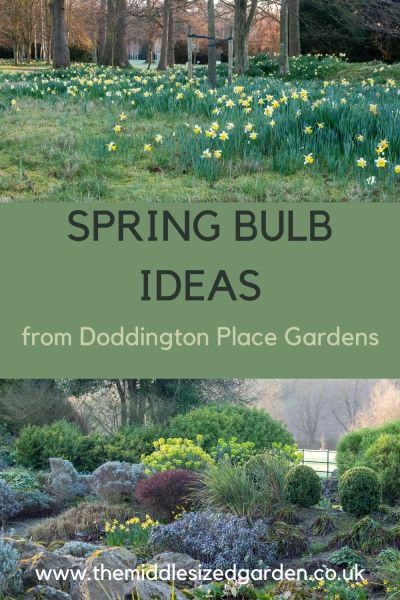
























> Lucy follows Fergus Garrett’s advice to keep a notebook with you when you’re in the garden.
Advice I got many years ago from a piece written by Christopher Lloyd.
There was this period in the late Roman Empire where the outgoing Emperor would “adopt a son” and appoint them their heir. I can’t help feel that Fergus is the Marcus Aurelius of the British gardening world.
I think you’re right!